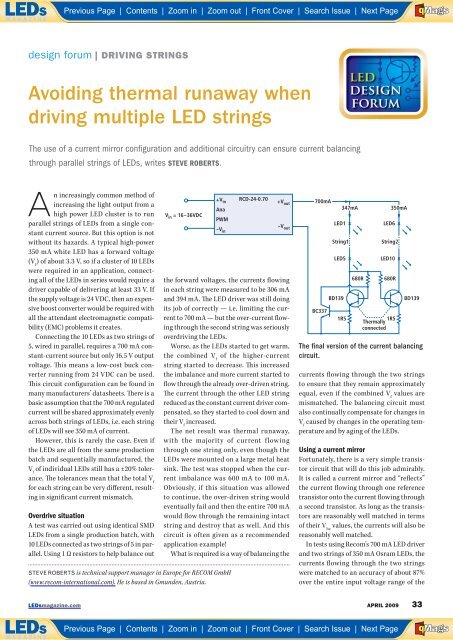Zoom In - Beriled
Zoom In - Beriled
Zoom In - Beriled
- No tags were found...
You also want an ePaper? Increase the reach of your titles
YUMPU automatically turns print PDFs into web optimized ePapers that Google loves.
Previous Page | Contents | <strong>Zoom</strong> in | <strong>Zoom</strong> out | Front Cover | Search Issue | Next PageABE FMaGSdesign forum | DRIVING STRINGSAvoiding thermal runaway whendriving multiple LED stringsThe use of a current mirror confi guration and additional circuitry can ensure current balancingthrough parallel strings of LEDs, writes STEVE ROBERTS.An increasingly common method ofincreasing the light output from ahigh power LED cluster is to runparallel strings of LEDs from a single constantcurrent source. But this option is notwithout its hazards. A typical high-power350 mA white LED has a forward voltage(V f) of about 3.3 V, so if a cluster of 10 LEDswere required in an application, connectingall of the LEDs in series would require adriver capable of delivering at least 33 V. Ifthe supply voltage is 24 VDC, then an expensiveboost converter would be required withall the attendant electromagnetic compatibility(EMC) problems it creates.Connecting the 10 LEDs as two strings of5, wired in parallel, requires a 700 mA constant-currentsource but only 16.5 V outputvoltage. This means a low-cost buck converterrunning from 24 VDC can be used.This circuit configuration can be found inmany manufacturers’ datasheets. There is abasic assumption that the 700 mA regulatedcurrent will be shared approximately evenlyacross both strings of LEDs, i.e. each stringof LEDs will see 350 mA of current.However, this is rarely the case. Even ifthe LEDs are all from the same productionbatch and sequentially manufactured, theV fof individual LEDs still has a ±20% tolerance.The tolerances mean that the total V ffor each string can be very different, resultingin significant current mismatch.Overdrive situationA test was carried out using identical SMDLEDs from a single production batch, with10 LEDs connected as two strings of 5 in parallel.Using 1 Ω resistors to help balance outV in = 16~36VDC+V inRCD-24-0.70+V outAnaPWM-V-V outinthe forward voltages, the currents flowingin each string were measured to be 306 mAand 394 mA. The LED driver was still doingits job of correctly — i.e. limiting the currentto 700 mA — but the over-current flowingthrough the second string was seriouslyoverdriving the LEDs.Worse, as the LEDs started to get warm,the combined V fof the higher-currentstring started to decrease. This increasedthe imbalance and more current started toflow through the already over-driven string.The current through the other LED stringreduced as the constant current driver compensated,so they started to cool down andtheir V fincreased.The net result was thermal runaway,with the majority of current flowingthrough one string only, even though theLEDs were mounted on a large metal heatsink. The test was stopped when the currentimbalance was 600 mA to 100 mA.Obviously, if this situation was allowedto continue, the over-driven string wouldeventually fail and then the entire 700 mAwould flow through the remaining intactstring and destroy that as well. And thiscircuit is often given as a recommendedapplication example!What is required is a way of balancing theSTEVE ROBERTS is technical support manager in Europe for RECOM GmbH(www.recom-international.com). He is based in Gmunden, Austria.700mABC337LED1String1LED5BD139347mA1R5680RLED6String2LED10680R1R5Thermallyconnected350mABD139The fi nal version of the current balancingcircuit.currents flowing through the two stringsto ensure that they remain approximatelyequal, even if the combined V fvalues aremismatched. The balancing circuit mustalso continually compensate for changes inV fcaused by changes in the operating temperatureand by aging of the LEDs.Using a current mirrorFortunately, there is a very simple transistorcircuit that will do this job admirably.It is called a current mirror and “reflects”the current flowing through one referencetransistor onto the current flowing througha second transistor. As long as the transistorsare reasonably well matched in termsof their V bevalues, the currents will also bereasonably well matched.<strong>In</strong> tests using Recom’s 700 mA LED driverand two strings of 350 mA Osram LEDs, thecurrents flowing through the two stringswere matched to an accuracy of about 87%over the entire input voltage range of theLEDsmagazine.com APRIL 2009 33Previous Page | Contents | <strong>Zoom</strong> in | <strong>Zoom</strong> out | Front Cover | Search Issue | Next PageABE FMaGS

















